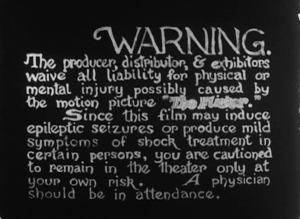Information
Information

Tony Conrad’s principal motivation in making his film The Flicker in 1965–66, “was to explore the possibilities for harmonic expression using a sensory mode other than sound. The experience of “flicker”—its peculiar entrapment of the central nervous system, by ocular driving—occurs over a frequency range of about 4 to 40 flashes per second” (Conrad and Duguid, 1996).
Devoid of any “flicker structures,” to use Conrad’s term, The Flicker consists of black and clear frames that alternate in varying rhythms to create a strobe effect, thus laying bare the mechanics of the moving image. Accompanied by music, the film begins with a message warning viewers that it “may induce epileptic seizures or produce mild symptoms of shock treatment.” When this message slowly fades, the movement of the filmstrip is exploited to create a relentless, stroboscopic chain of contrasts between black and clear frames, accompanied by sound effects and directly engaging the physiology of the beholder. Being an orchestrated rather than open work, unlike Zen for Film, The Flicker leaves little to chance and is the opposite of boring. Like Zen for Film, although from the other side of the experimental film spectrum, The Flicker is a radical departure from Hollywood-style cinema, eschewing narrative for the stimulation of physiological reactions by minimal material means. —LS
Film: Courtesy of the artist.